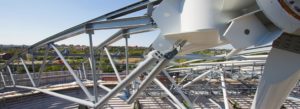May 13, 2016

In FIMECC BSA program VTT has developed together with Ruukki Construction and SSAB, acceptance criteria for new constructional high-strength steel grades. A new method to define the requirements for determination of material ductility parameters was described. The method was applied for the verification of local failure of structural parts with holes. The criteria developed enable the wider utilisation of high strength steels in construction industry.
The new design codes and acceptance criteria for high strength steels in civil engineering applications and construction industry were developed. The developed acceptance criteria enable the wider utilisation of high strength steels in construction industry. The utilisation of high strength steels enables the weight savings and reduction of carbon footprint in construction industry.
The method is based on the requirement that a structural member has to reach its design resistance without ductile failure. Then the material has to tolerate certain plastic strains in localized areas around holes and notches. The material’s ability to deform can be expressed by the difference between uniform elongation eu and elongation at failure A5 called “necking capacity”. For example this necking capacity had to be at least 6% in details with holes and notches studied in the project.
These ductility limits are based on virtual testing of real details with simplified tri-linear true stress-strain material model. Results for standard tension coupons, tension specimens and beams were achieved by fully automated numerical FEM procedures developed in VTT. The study with about 200 material models covered all standard structural steels. The method was validated by experiments with central hole in tension specimens provided by Ruukki Construction and SSAB.
The use of high-strength steels in civil engineering has been mainly limited to weight optimized applications, such as vehicle bodies, lifting and hoisting devices. Occasionally they are also used in statically loaded structures as in drilling rigs, pipelines, heavy industrial plants, bridges and long span trusses. Savings in weight reduce the carbon footprint in manufacture and transport. The outstanding properties of these steels could be utilized more widely in the construction industry, if the design codes were up to date.
Eurocode rules cover structural steel grades up to S700, but no higher. Moreover, the relatively high ductility requirements of the Eurocode form a barrier for the use of many high strength steels in construction industry. Therefore, complementary to experimental results, improved numerical methods are needed for the assessment of the required material ductility in different structural details.
The study is a part of FIMCC BSA project – Design beyond present codes. Therefore, the project deliverables, together with related EU level projects (e.g. Rules on high strength steel, RUOSTE, and Material choice for seismic resistant structures , MATCH), will be used for extending the relevant parts of Eurocode 3 for high strength steel grades (S960 and higher). It is demonstrated that the lower values of ductility parameters than given in the Eurocode can be used. The wider utilisation of high strength steels in construction industry enables the weight savings and reduction of carbon footprint of buildings and infrastructures. It also creates opportunities for the new products development.
The advanced and fully automated numerical procedure (virtual testing) developed for the study can also serve as a practical design tool. Designers can use it to validate case-by-case the ability of certain material to reach specific design limits for a particular detail or to optimize its geometry.
